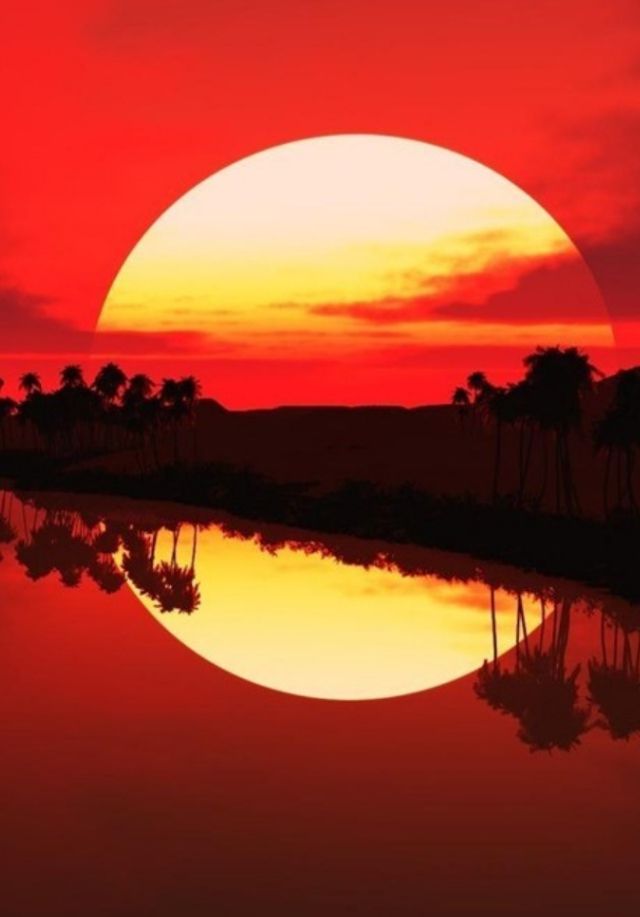I came across the red like sunset today.


Everyone at one time or another has marveled at the beautiful red and orange colors of a sunrise or sunset. Although colorful sunrises and sunsets can be seen anywhere, certain parts of the world are especially famous for their twilight hues. The deserts and tropics quickly come to mind. Indeed, it is a rare issue of Arizona Highways that does not include at least one sunset view, and one could amass a respectable collection of Caribbean or Hawaiian sunset postcards in just one trip.
Eye-catching sunrises and sunsets also seem to favor certain times of the year. In the middle latitudes and over the eastern half of the United States, for example, fall and winter generally produce the most spectacular low-sun hues.
Why do some parts of the world enjoy more beautiful sunsets than others, and why do they favor certain months? What are the ingredients for truly memorable sunrises and sunsets? These and other twilight topics are explored in the paragraphs that follow...
What dust and pollution don't do
It is often written that natural and manmade dust and pollution cause colorful sunrises and sunsets. Indeed, the brilliant twilight "afterglows" that follow major volcanic eruptions owe their existence to the ejection of small particles high into the atmosphere (more will be said on this a bit later). If, however, it were strictly true that low-level dust and haze were responsible for brilliant sunsets, cities such as New York, Los Angeles, London, and Mexico City would be celebrated for their twilight hues. The truth is is that tropospheric aerosols --- when present in abundance in the lower atmosphere as they often are over urban and continental areas --- do not enhance sky colors --- they subdue them. Clean air is, in fact, the main ingredient common to brightly colored sunrises and sunsets.
To understand why this is so, one need only recall how typical sky colors are produced. The familiar blue of the daytime sky is the result of the selective scattering of sunlight by air molecules. Scattering is the scientific term used to describe the reflection or re-direction of light by small particles. Scattering by dust or by water droplets is responsible for the shafts of light that appear when the sun partly illuminates a smoky room or mist-laden forest. Selective scattering, also known as Rayleigh scattering (after the nineteenth century English physicist Lord Rayleigh), is used to describe scattering that varies with the wavelength of the incident light. Particles are good Rayleigh scatterers when they are very small compared to the wavelength of the light.
Ordinary sunlight is composed of a spectrum of colors that grade from violets and blues at one end to oranges and reds on the other. The wavelengths in this spectrum range from .47 um for violet to .64 um for red. Air molecules are much smaller than this --- about a thousand times smaller. Thus, air is a good Rayleigh scatterer. But because air molecules are slightly closer in size to the wavelength of violet light than to that of red light, pure air scatters violet light three to four times more effectively than it does the longer wavelengths. In fact, were it not for the fact that human eyes are more sensitive to blue light than to violet, the clear daytime sky would appear violet instead of blue!
At sunrise or sunset, sunlight takes a much longer path through the atmosphere than during the middle part of the day. Because this lengthened path results in an increased amount of violet and blue light being scattered out of the beam by the nearly infinite number of scattering "events" that occur along the way (a process collectively known as multiple scattering), the light that reaches an observer early or late in the day is noticeably reddened. Thus, it could be said that sunsets are red because the daytime sky is blue. This notion is perhaps best illustrated by example: A beam of sunlight that at a given moment helps produce a red sunset over the Appalachians is at the same time contributing to a deep blue, late afternoon sky over the Rockies....
to be continued#